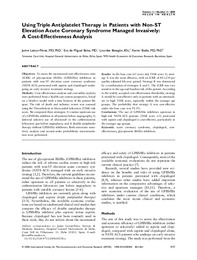Título :
Using Triple Antiplatelet Therapy in Patients with Non-ST Elevation Acute Coronary Syndrome Managed Invasively
A Cost-Effectiveness Analysis |
Autor :
Latour-Perez, Jaime 
de Miguel Balsa, Eva 
Betegón, Lourdes
Badia, Xavier |
Editor :
Malden, MA : Blackwell Science; Elsevier |
Departamento:
Departamentos de la UMH::Medicina Clínica |
Fecha de publicación:
2008 |
URI :
https://hdl.handle.net/11000/34615 |
Resumen :
Objectives: To assess the incremental cost-effectiveness ratio (ICER) of glycoprotein IIb/IIIa (GPIIb/IIIa) inhibitors in patients with non-ST elevation acute coronary syndrome (NSTE-ACS) pretreated with aspirin and clopidogrel undergoing an early invasive treatment strategy.
Methods: Cost-effectiveness analysis and cost-utility analysis were performed from a health-care system perspective, based on a Markov model with a time horizon of the patient life span. The risk of death and ischemic events was assessed using the Thrombolysis in Myocardial Infarction (TIMI) risk score. We compared three strategies: 1) routine upstream use of a GPIIb/IIIa inhibitor to all patients before angiography, 2)
deferred selective use of abciximab in the catheterization laboratory just before angioplasty, and 3) double antiplatelet therapy without GPIIb/IIIa inhibitors. Both univariate sensitivity analysis and second-order probabilistic microsimulation were performed.
Results: In the base case (65 years old, TIMI score 3), strategy A was the most effective, with an ICER of €15,150 per quality-adjusted life-year gained. Strategy B was dominated by a combination of strategies A and C. The ICER was very sensitive to the age and baseline risk of the patient. According
to the widely accepted cost-effectiveness thresholds, strategy A would be cost-effective only in patients with an intermediate to high TIMI score, especially within the younger age groups. The probability that strategy A was cost-effective under the base case was 91.2%.
Conclusions: The use of GPIIb/IIIa inhibitors upstream in high-risk NSTE-ACS patients (TIMI score 3) pretreated
with aspirin and clopidogrel is cost-effective, particularly in the younger age groups.
Keywords:
|
Palabras clave/Materias:
acute coronary syndrome
clopidogrel
costeffectiveness
glycoprotein IIb/IIIa inhibitors |
Tipo de documento :
info:eu-repo/semantics/article |
Derechos de acceso:
info:eu-repo/semantics/openAccess
Attribution-NonCommercial-NoDerivatives 4.0 Internacional |
DOI :
10.1111/j.1524-4733.2008.00338.x |
Publicado en:
Value Health. 2008 Sep-Oct;11(5):853-61 |
Aparece en las colecciones:
Artículos Medicina Clínica
|
 La licencia se describe como: Atribución-NonComercial-NoDerivada 4.0 Internacional.
La licencia se describe como: Atribución-NonComercial-NoDerivada 4.0 Internacional.
.png)
